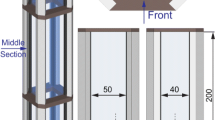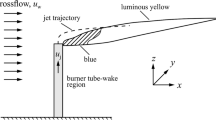Abstract
The flame behavior and thermal structure of combusting plane jets with and without self-excited transverse oscillations were investigated experimentally. The transversely-oscillating plane jet was generated by a specially designed fluidic oscillator. Isothermal flow patterns were observed using the laser-assisted smoke flow visualization method. Meanwhile, the flame behaviour was studied using instantaneous and long-exposure photography techniques. Temperature distributions and combustion-product concentrations were measured using a fine-wire type R thermocouple and a gas analyzer, respectively. The results showed that the combusting transversely-oscillating plane jets had distributed turbulent blue flames with plaited-like edges, while the corresponding combusting non-oscillating plane jet had laminar blue-edged flames in the near field. At a high Reynolds number, the transversely-oscillating jet flames were significantly shorter and wider with shorter reaction-dominated zones than those of the non-oscillating plane jet flames. In addition, the transversely-oscillating combusting jets presented larger carbon dioxide and smaller unburned hydrocarbon concentrations, as well as portrayed characteristics of partially premixed flames. The non-oscillating combusting jets presented characteristics of diffusion flames, and the transversely-oscillating jet flame had a combustion performance superior to its non-oscillating plane jet flame counterpart. The high combustion performance of the transversely-oscillating jets was due to the enhanced entrainment, mixing, and lateral spreading of the jet flow, which were induced by the vortical flow structure generated by lateral periodic jet oscillations, as well as the high turbulence created by the breakup of the vortices.















Similar content being viewed by others
Abbreviations
- b :
-
Width of exit slots of fluidic oscillator, 0.5 mm.
- C CO :
-
Concentrations of carbon monoxide.
- C CO2 :
-
Concentrations of carbon dioxide.
- C O2 :
-
Concentrations of oxygen.
- C UHC :
-
Concentrations of unburned hydrocarbons.
- d :
-
Width of fluidic oscillator passageway, 1 mm.
- d p :
-
Width of jet exit, 11 mm.
- h :
-
Offset distance from crescent origin to virtual vertex of target blockage, 2 mm.
- H f :
-
Flame length, m.
- l :
-
Length of deflection plates, 5.5 mm.
- Q j :
-
Volumetric flow rate of fluid jet measured by rotameter, m3/s.
- R :
-
Radius of crescent profile of the target blockage, 4.5 mm.
- Rej :
-
Reynolds number of fuel jet flow, = u j d p/ν j.
- s :
-
Span length of burners, 36 mm.
- T :
-
Temperature, °C.
- t :
-
Evolution time, s.
- t* :
-
Non-dimensional evolution time, = tu c/d p.
- UHC:
-
Unburned hydrocarbons.
- u c :
-
Average jet velocity at the nozzle inlet, m/s.
- u j :
-
Average exit velocity of plane jet, = Q j/(sd p ), m/s.
- u’ :
-
Root mean square of fluctuating velocity, m/s.
- w :
-
Cross-stream distance between exit slots of fluidic oscillator, 16.4 mm.
- w b :
-
Downstream width of target blockage, 15 mm.
- W b :
-
Overall width of burners, 36 mm.
- W f :
-
Flame width, m.
- x, y, z :
-
Coordinates in lateral, span, and axial directions fixed at centre of burner exit plane.
- θ :
-
Deflection angle of deflection plates measured from horizontal axis, 30 degrees.
- ν j :
-
Kinematic viscosity of jet fluid, m2/s
References
Gordeyev SV, Thomas FO (2002) Coherent structure in the turbulent planar jet. part 2. Structural topology via POD eigenmode projection. J Fluid Mech 460:349–380. https://doi.org/10.1017/S0022112002008364
Landel JR, Caulfield CP, Woods AW (2012) Meandering due to large eddies and the statistically self-similar dynamics of quasi-two-dimensional jets. J Fluid Mech 692:347–368. https://doi.org/10.1017/jfm.2011.518
Manivannan P, Sridhar BTN (2013) Characteristic study of non-circular incompressible free jet. Therm Sci 17(3):787–800. https://doi.org/10.2298/TSCI110208116M
Mi J, Nathan GJ (2010) Statistical properties of turbulent free jets issuing from nine differently-shaped nozzles. Flow Turbulence Combust 84:583–606. https://doi.org/10.1007/s10494-009-9240-0
Wygnanski BI, Fiedler H (1969) Some measurements in the self-preserving jet. J Fluid Mech 38(part 3):577–612
Coles D (1985) The use of coherent structures. AIAA Paper 1985–0506
Brown GL, Roshko A (1974) On density effects and large structure in turbulent mixing layers. J Fluid Mech 64(part 4):775–816
Koched A, Pavageau M, Aloui F (2011) Vortex structure in the wall region of an impinging plane jet. Journal of Applied Fluid Mechanics 4(2, Special Issue):61–69
Chang KT, Huang RF (2004) Development and characterization of jet-injected vee-gutter. J Mech 20(1):77–83
Huang RF, Chang KT (2005) Fluidic oscillation influences on v-shaped bluffbody flow. AIAA J 43(11):2319–2328. https://doi.org/10.2514/1.13604
Huang RF, Chang KT (2007) Evolution and turbulence properties of self-sustained transversely oscillating flow induced by fluidic oscillator. J Fluids Eng 129(8):1038. https://doi.org/10.1115/1.2746905
Mataoui A, Schiestel R (2009) Unsteady phenomena of an oscillating turbulent jet flow inside a cavity: Effect of aspect ratio. Journal of Fluids and Structures 25:60–79. https://doi.org/10.1016/j.jfluidstructs.2008.03.010
Mi J, Nathan GJ (2004) Self-excited jet-precession strouhal number and its influence on downstream mixing field. Journal of Fluids and Structures 19(6):851–862. https://doi.org/10.1016/j.jfluidstructs.2004.04.006
Wong CY, Nathan GJ, O'Doherty T (2004) The effect of initial conditions on the exit flow from a fluidic precessing jet nozzle. Exp Fluids 36:70–81. https://doi.org/10.1007/s00348-003-0642-9
Tomac MN, Gregory JW (2014) Internal flow physics of a fluidic oscillator in the transition regime. Active Flow & Combustion Control AFCC 2014 (Berlin 2014)
Sun C-L, Sun C-Y (2011) Effective mixing in a microfluidic oscillator using an impinging jet on a concave surface. Microsyst Technol 17:911–922. https://doi.org/10.1007/s00542-010-1177-7
Tesař V, Smyk E, Peszynski K (2014) Fluidic oscillator with bistable turn-down amplifier. Colloquium Fluid Dynamics 2014:1–14. https://doi.org/10.13140/2.1.1702.1448
Yang J-T, Chen C-K, Hu I-C, Lyu P-C (2007) Design of a self-flapping microfluidic oscillator and diagnosis with fluorescence methods. J Microelectromech Syst 16(4):826–835. https://doi.org/10.1109/JMEMS.2007.899338
Gregory JW, Sullivan JP, Raman G, Raghu S (2004) Characterization of a micro fluidic oscillator for flow control. 2nd AIAA Flow Control Conference AIAA 2004–2692
Yang J-T, Chen C-K, Tsai K-J, Lin W-Z, Sheen H-J (2007) A novel fluidic oscillator incorporating step-shaped attachment walls. Sensors Actuators A 135:476–483. https://doi.org/10.1016/j.sna.2006.09.016
Deo RC, Mi J, Nathan GJ (2007) The Influence of nozzle aspect ratio on plane jets. Exp Thermal Fluid Sci 31(8):825–838. https://doi.org/10.1016/j.expthermflusci.2006.08.009
Kalghatgi GT (1984) Lift-off heights and visible lengths of vertical turbulent jet diffusion flames in still air. Combust Sci Technol 41:17–29. https://doi.org/10.1080/00102208408923819
Peters N, Williams FA (1983) Liftoff characteristics of turbulent jet diffusion flames. AIAA J 21(3):423–429
Chung SH, Lee BJ (1991) On the characteristics of laminar lifted flames in a nonpremixed jet. Combustion and Flame 86:62–72
Iyogun CO, Birouk M (2008) Effect of fuel nozzle geometry on the stability of a turbulent jet methane flame. Combust Sci Technol 18(12):2186–2209. https://doi.org/10.1080/00102200802414980
Huang RF, Chang KT (2004) Oscillation frequency in wake of a vee gutter. J Propuls Power 20(5):871–878. https://doi.org/10.2514/1.9431
Huang RF, Yang HF, Hsu CM (2012) Flame behavior and thermal structure of combusting nonpulsating and pulsating plane jets. J Propuls Power 29(1):114–124. https://doi.org/10.2514/1.B34580
Yang HF, Hsu CM, Huang RF (2014) Flame behavior of bifurcated jets in a v-shaped bluff-body burner. J Mar Sci Technol 22(5):606–611. https://doi.org/10.6119/JMST-013-1025-1
Yang HF, Hsu CM, Huang RF (2014) Controlling Plane-Jet Flame by a Fluidic Oscillation Technique. J Eng Gas Turbines Power 136(041501):1–10. https://doi.org/10.1115/1.4025928
Glassman I, Yetter RA (2008) Combustion. Fourth edn. Elsevier Inc., London
Author information
Authors and Affiliations
Corresponding author
Ethics declarations
Conflict of interest
On behalf of all authors, the corresponding author states that there is no conflict of interest.
Rights and permissions
About this article
Cite this article
Huang, R.F., Kivindu, R.M. & Hsu, C.M. Flame behavior and thermal structure of combusting plane jets with and without self-excited transverse oscillations. Heat Mass Transfer 54, 1681–1696 (2018). https://doi.org/10.1007/s00231-017-2268-0
Received:
Accepted:
Published:
Issue Date:
DOI: https://doi.org/10.1007/s00231-017-2268-0




